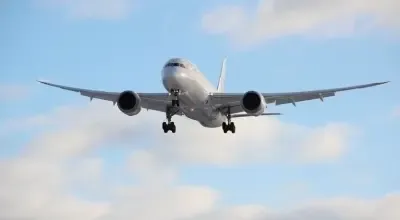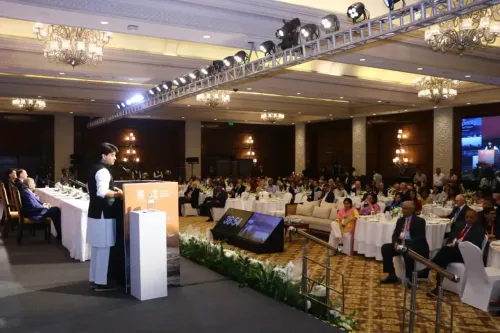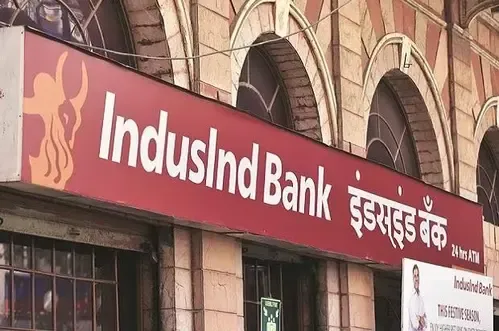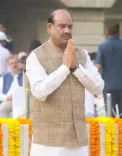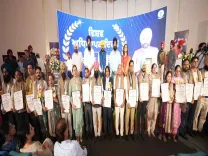Is Delhi a shining example of development? PM Modi inaugurates two major highways in a significant boost for Delhi-NCR infrastructure
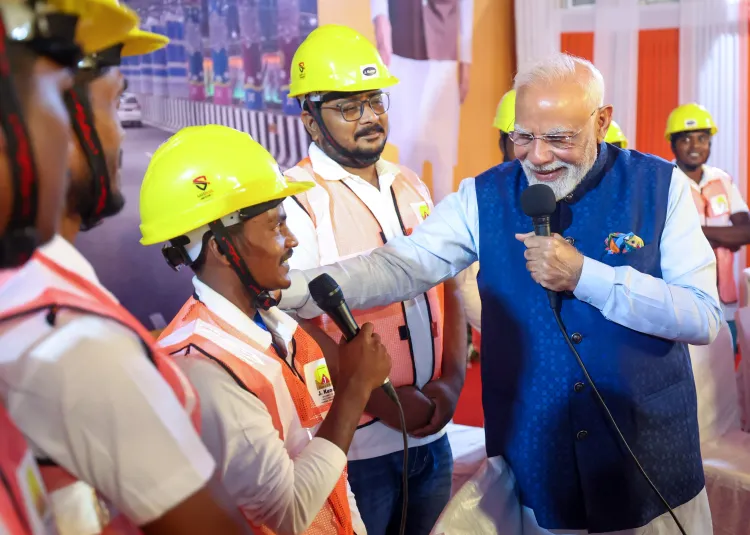
Synopsis
Key Takeaways
- Investment: Rs 11,000 crore for two highway projects.
- Length: UER-II spans 54.21 km.
- Environmental Impact: Utilizes waste from Ghazipur landfill.
- Travel Time Reduction: 40 to 60 percent decrease from IGI Airport.
- Improved Connectivity: Links with major highways and reduces congestion.
New Delhi, Aug 17 (NationPress) Prime Minister Narendra Modi inaugurated two significant highway projects—the Delhi segments of the Urban Extension Road-II (UER-II) and the Dwarka Expressway, which were developed with a funding of Rs 11,000 crore. These initiatives aim to alleviate persistent traffic congestion in the national capital and enhance connectivity throughout the National Capital Region (NCR).
During the inauguration at Rohini, PM Modi remarked: "Delhi has emerged as a shining example of the progress occurring in our nation."
The newly launched projects are expected to facilitate travel, save time, and enhance the convenience for traders, farmers, and all Delhi residents.
The Prime Minister highlighted how the infrastructure in Delhi-NCR has reached a world-class standard over the last decade, benefiting the populace through improved travel. He assured that efforts to further develop Delhi are ongoing, with numerous projects in the pipeline.
PM Modi noted that these two initiatives have contributed to decreasing the waste mountains in Delhi and enhancing the quality of life for its citizens.
He took a moment to engage with the construction workers responsible for the Expressway, commending their dedication in completing these remarkable infrastructure projects that will minimize travel time, redirect freight traffic from the city center, and alleviate congestion on Delhi's congested Inner and Outer Ring Roads.
Additionally, he discussed the specifics of the projects with officials, which encompass extensive tunnels, underpasses, and elevated sections.
Union Road Transport and Highways Minister Nitin Gadkari remarked that these projects were initiated under the Prime Minister’s vision to decongest Delhi and enhance connectivity in the national capital and neighboring NCR. Both projects are designed with state-of-the-art technology, totaling 563 km for a single project.
The flagship project spans 54.21 km for UER-II, stretching from Alipur through Bawana, Rohini, Mundka, Bakkarwala, Najafgarh, and Dwarka to Dichaon Kalan, with an investment of Rs 5,580 crore.
This six-lane highway, envisioned as Delhi's third ring road under the Delhi Master Plan Road 2021, features new connections to Bahadurgarh and Sonipat.
The corridor is anticipated to ease traffic on Delhi's Inner and Outer Ring Roads and at busy intersections like Mukarba Chowk, Dhaula Kuan, and NH-9.
The new links will enhance industrial connectivity, reduce city traffic, and accelerate goods movement within the NCR.
It is projected to decrease travel time from Indira Gandhi International Airport to various locations in southwest and northwest Delhi by 40 to 60 percent, as per government estimates.
Officials claim that this route will provide expedited connectivity for commuters traveling from Chandigarh to Gurugram and Delhi's IGI Airport.
Sections around Najafgarh, Mundka, and Alipur have already opened in phases, benefiting previously undeveloped zones like Karala, Alipur, and Bawana.
The new route offers quicker access to south Delhi, Noida, and Faridabad while improving connectivity to locations such as Dwarka, Mahipalpur, and Vasant Kunj.
The complete UER-II measures 76 km—54.21 km in Delhi and 21.5 km in Haryana—with a total construction expenditure of Rs 8,000 crore.
Recognized as a national highway, the project is being executed by the National Highways Authority of India in five segments, with the Delhi Development Authority financing the capital's portion.
The second initiative involves a 10.1 km stretch of the Dwarka Expressway, constructed at Rs 5,360 crore.
This bypass of NH-48 for the Delhi-Gurugram Expressway features an underpass near the airport and establishes direct connectivity from IGI Airport to UER-II, Gurugram, and Dwarka.
The route provides a direct pathway to Yashobhoomi in Dwarka's Sector 25 and will also facilitate multi-modal connectivity to Delhi Metro's Blue and Orange Lines, the upcoming Bijwasan railway station, and the Dwarka cluster bus depot.
The construction of the Dwarka Expressway has already decreased travel time for areas in the capital, such as Dwarka, Mahipalpur, Vasant Kunj, and Najafgarh, improving connectivity to Gurugram and key sites like IGI Airport.
The Delhi segment includes two stretches: 5.9 km from Shiv Murti intersection near the airport to Dwarka Sector 21, and 4.2 km from Sector 21 to the Delhi-Haryana border. The route contains a tunnel to ensure uninterrupted traffic flow.
The 19 km Haryana section of the Dwarka Expressway was inaugurated by the Prime Minister on March 11, 2024. The entire 28 km corridor was constructed at Rs 8,611 crore.
Construction has implemented environmental measures, utilizing two million tonnes of waste from the Ghazipur landfill in UER-II development, thereby reducing the waste mountain's height by seven meters.
Union Minister Gadkari emphasized this during the Delhi Assembly election campaigning earlier this year.
"We are employing inert materials retrieved through biomining of legacy waste for highway construction to encourage sustainable infrastructure," stated an NHAI official.
The official noted, "These inert materials, which include soil, silt, stones, and construction debris, are stable and suitable for embankment filling, subgrade layering, and service roads."
The inert materials are also being used for various projects, including the DND-Faridabad Bailabgarh Sohna bypass, aimed at minimizing landfill volume, conserving natural resources, and reducing construction costs and carbon emissions.
Delhi Chief Minister Rekha Gupta, along with senior officials and party leaders, visited the inauguration site on Saturday to assess the preparations and provided necessary guidance.
She characterized the projects as a "historic gift" for the city.
"The launch of UER-II will play a crucial role in mitigating congestion, enhancing the industrial corridor network, reducing vehicular pollution, and thus contributing to a cleaner and healthier environment," Gupta stated.
"UER-II is more than just an infrastructure project; it represents an investment in Delhi's future. It will enhance traffic flow, significantly reduce travel time, and elevate the quality of life for millions living in Delhi and NCR," she added.
She also underscored the long-distance connectivity that UER-II will provide, indicating that the route will connect with the Delhi-Jaipur national highway, KMP Expressway, and Gurugram-Sohna Highway, leading to the Delhi-Mumbai Expressway.
"Traveling to Chandigarh, Punjab, Jammu and Kashmir, Jaipur, and even Mumbai will become faster and more convenient. This is truly a transformative venture," she remarked.
"With this network, UER-II will serve as a backbone of high-speed connectivity, linking Delhi not only with NCR but with the entire nation," CM Gupta concluded.
These projects are integral to the government's broader strategy to alleviate congestion in the national capital, although transport experts have previously raised concerns about whether new roads provide sustainable relief or simply shift bottlenecks elsewhere.

